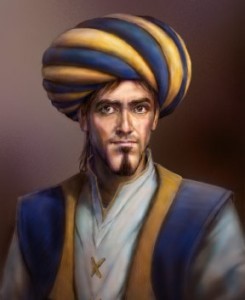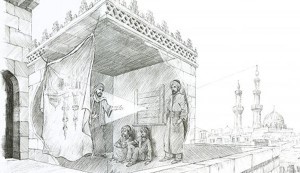
Source: Creative representation bust of Ibn al-Haytham made by artist Ali Amro for 1001 Inventions to celebrate the UNESCO International Year of Light 2015 (© 1001 Inventions)
Profile: Ibn Al Hazen – The Secrets of Sight and the Foundation of Source:the Scientific Method
Ibn al-Haytham (known in the west by his Latinized name ‘Alhazen’) was born c. 965 to an Arab family in Basra, Iraq, which at the time was part of the Buyid emirate. Ibn al-Haytham had a passionate desire to understand nature. He questioned everything, especially those things that everyone else took for granted. “How do we see?” he asked.
Some of the great authorities who came before him had theorized that sight was a result of rays emitted by our eyes, returning to them after having travelled to the objects that we see. Al-Haytham disagreed, he reasoned that the stars were far too distant for something from our eyes to travel all the way to them and back, in the blink of an eye. Excellent reasoning, but al-Haytham didn’t stop there. Aided by a culture which was open to new ideas and questioning, he continued his search for ways to compel nature to divulge her secrets.

Source: An early diagram of the human eye by Ibn al-Haytham, 1000 AD (as cited in Carr, 2018)
It was the golden age of science in the Islamic world – one that stretched from Cordoba in Spain all the way to Samarkand in Central Asia. Christian and Jewish scholars were honoured guests at the research institutes of Baghdad, Cairo, and other Islamic capitals. Far from the controversial burning of books, the caliphs of the time sent emissaries across the known world in search of any texts containing knowledge. They spent lavishly on projects to study, translate, and preserve these works for future generations. Much of what we know about ancient Greek science, math and philosophy was exhumed by Islamic scholars and would surely have been lost without their efforts.
The reawakening of scientific thought that took place in Europe, hundreds of years later, was kindled by the embers of a fire long tended to by scholars and scientists from the Muslim world. The Muslims also became the conduit through which ideas from India traveled to the West, including, the so-called Arabic numerals that we all use today, and the concept of zero, without which large calculations are practically impossible.
Modern astronomy was so greatly influenced by medieval Islamic scholarship, that to this day we refer to many stars by their Arabic names. Similarly, the “al’s” in algebra, algorithm, alchemy, and alcohol are just some of the traces left behind from a time when Arabic was the language of science.
Ibn al-Haytham is widely regarded as the first person to set down the rules of science, or what we now know as the ‘scientific method’. He created a thorough, systematic and empirical method to sift out misconceptions in one’s thinking. He would tell his students:
“Finding truth is difficult and the road to it is rough. As seekers after truth, you will be wise to withhold judgment and not simply put your trust in the writings of the ancients. You must question and critically examine those writings from every side. You must submit only to argument and experiment and not to the sayings of any person. For every human being is vulnerable to all kinds of imperfection.
As seekers after truth, we must also suspect and question our own ideas as we perform our investigations, to avoid falling into prejudice or careless thinking. Take this course, and the truth will be revealed to you. This is the method of science.”
– Ibn al-Haytham (as cited in Sabra, 2003)
In the 11th century, Ibn al-Haytham set about trying to test his ideas about light and how we see. He devised an experiment to determine how light moves. He erected a tent and sealed it tightly, leaving space for only a single ray of light to pierce its inner darkness. With little more than his intelligence and a wooden ruler, al-Haytham accomplished a great leap forward in the history of science. His experiment showed that light moves in straight lines. But that was not all.

Source: Camera Obscura in the 11th Century
Al-Haytham made his own camera obscura and dazzled the caliphs. He figured out that the key to forming any image – whether in relation to an eye or a camera obscura – was to create a small opening to restrict the amount of light that could enter an otherwise dark chamber. The small aperture allowed light from only a few directions to enter, forming a sharp image. As a result, instead of being blinded by the light, one could see a distinct image form on the screen opposite the tiny hole. In the modern day, space telescopes such as the Hubble, have captured light from the most distant and ancient galaxies, giving us increasingly clearer pictures of the cosmos.
In the next part of the series, we will learn how ancient Greek thinkers proved that the universe is infinite and that the Earth is round without any of the technology that we now possess. They used only their reasoning and the scientific method, tools that are available to all of us regardless of our social status, educational background, or access to facilities.
References:
Sabra, A. (2003). Ibn al-Haytham – Brief life of an Arab mathematician: died circa 1040. [online] Harvard Magazine. Available at: http://harvardmagazine.com/2003/09/ibn-al-haytham-html.
BRAGA, B., et al. (2014). Cosmos: a spacetime odyssey.
1001 Inventions. (2015). Who was Ibn al-Haytham? [online] Available at: http://www.ibnalhaytham.com/discover/who-was-ibn-al-haytham/.
Carr, K. (2018). Ibn al-Haytham – Medieval Islamic science | Quatr.us Study Guides. [online] Quatr.us Study Guides. Available at: https://quatr.us/islam/ibn-al-haytham-medieval-islamic-science.htm.
